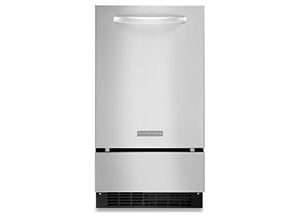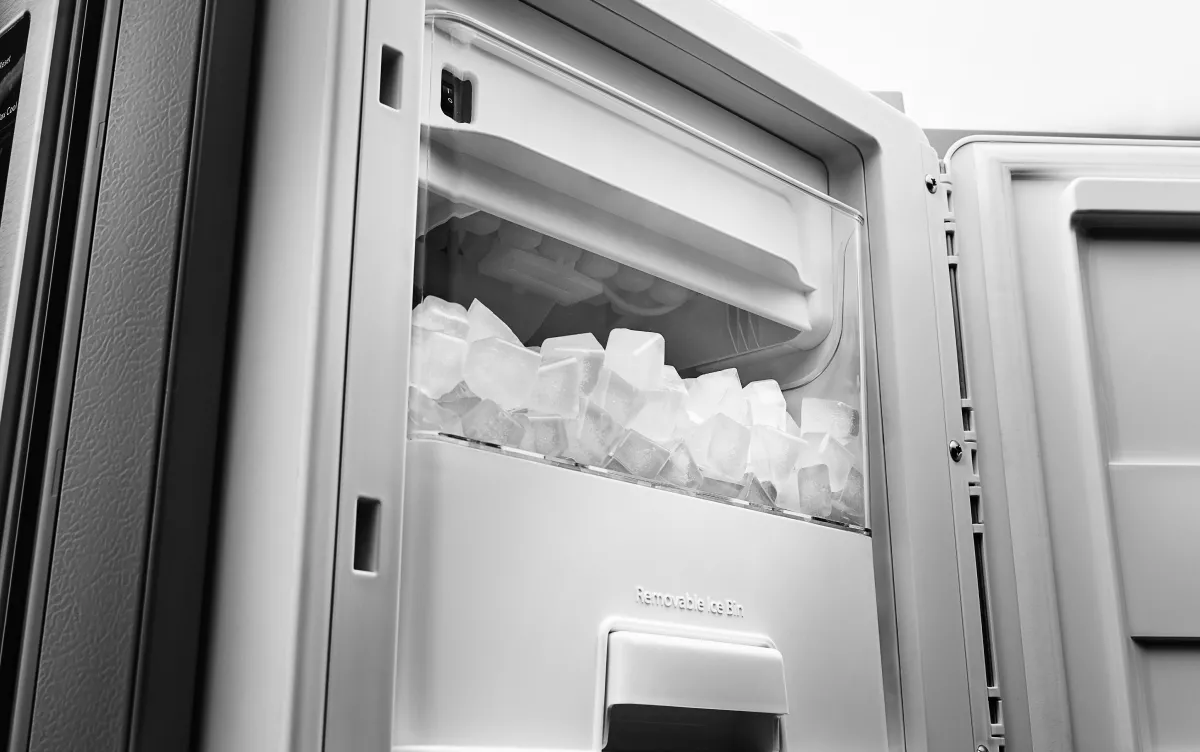KitchenAid undercounter ice makers are a great addition to any home. They provide a steady supply of ice for drinks and parties.
But what happens when they stop working correctly? Troubleshooting your KitchenAid undercounter ice maker can save time and money. Understanding common problems and simple fixes can help you avoid costly repairs. In this guide, we’ll explore the most frequent issues, from ice not forming to strange noises.
We’ll offer practical solutions you can try at home. Whether you are dealing with a clogged water line or a faulty thermostat, our tips will help you get your ice maker back in shape. Stay tuned to learn more about keeping your KitchenAid ice maker running smoothly.
Common Issues
Dealing with issues related to your Kitchenaid undercounter ice maker? Understanding common problems can save you time and frustration. Here are some frequent issues you might encounter.
No Ice Production
If your Kitchenaid ice maker is not producing ice, check the water supply. Ensure the water line is connected and turned on. Examine the filter; a clogged filter can block water flow. Replace it if necessary.
Inspect the ice maker’s power supply. Make sure it’s plugged in and the circuit breaker hasn’t tripped. Sometimes, the ice maker can be accidentally turned off. Look for the power switch and turn it on if needed.
Slow Ice Making
Your Kitchenaid ice maker might be producing ice slowly. Check the temperature settings. The ideal freezer temperature is between 0°F and 5°F. Adjust if necessary.
Regularly clean the ice maker. Mineral deposits can build up and slow production. Use a mixture of warm water and vinegar to clean the components. Make sure to dry them thoroughly before reassembling.
Ensure proper ventilation around the unit. Poor airflow can affect ice production. Keep the area around the ice maker free from obstructions.
Basic Checks
Before diving into complex fixes, perform some basic checks. These simple steps can often resolve many common issues with your Kitchenaid Undercounter Ice Maker. Let’s start with checking the power supply and water supply.
Power Supply
The first step is to ensure the ice maker has power. Follow these steps:
- Check the power cord: Make sure it is plugged in securely.
- Inspect the outlet: Plug another device to see if the outlet works.
- Examine the circuit breaker: Ensure the breaker hasn’t tripped. Reset if needed.
If all these are fine, the power supply is not the issue. Move on to the water supply check.
Water Supply
An ice maker needs a reliable water supply. Verify this by following these steps:
- Check the water line: Ensure it is connected properly.
- Inspect for kinks: Straighten out any kinks in the water line.
- Ensure the valve is open: The water valve should be fully open.
If water is still not flowing, there might be a blockage. Check the filter and clean or replace it if necessary. If these steps don’t help, further troubleshooting may be required.
Cleaning The Ice Maker
Regular cleaning of your Kitchenaid Undercounter Ice Maker ensures it runs efficiently. It prevents mold and mineral buildup, making sure you always have clean, fresh ice. Follow this simple guide to keep your ice maker in top shape.
Cleaning Tools
Gather these tools before you start:
- Soft cloth or sponge
- Warm water
- Mild dish soap
- Vinegar or ice machine cleaner
- Clean, dry towel
Step-by-step Guide
Follow these steps to clean your ice maker:
- Turn off the ice maker. Unplug it from the power source.
- Remove all ice. Discard any ice in the bin.
- Clean the interior. Use a soft cloth or sponge with warm, soapy water.
- Rinse with clean water. Make sure to remove all soap residue.
- Use vinegar or cleaner. Wipe the interior with a mixture of water and vinegar or a special ice machine cleaner.
- Dry thoroughly. Use a clean, dry towel to wipe down all surfaces.
- Clean the exterior. Wipe down the outside with a damp cloth.
- Plug in and restart. Turn the ice maker back on and let it run a cycle.
Regular cleaning helps your ice maker perform better and last longer. Make it a habit to clean it every six months or as needed.

Credit: edmondappliancerepairokc.com
Inspecting The Water Filter
The water filter is a crucial part of your Kitchenaid undercounter ice maker. It ensures the ice is clean and tastes good. Inspecting and maintaining it is essential for optimal performance. This section covers how to locate and replace the water filter.
Filter Location
Finding the water filter is the first step. It is usually located inside the ice maker. Often, it is near the bottom front panel. Sometimes, you may need to open a compartment to access it. Check your user manual for the exact location.
Replacement Instructions
Replacing the water filter is simple. First, turn off the ice maker. Then, locate the filter and twist it counterclockwise to remove it. Insert the new filter and twist it clockwise until it locks in place. Finally, turn the ice maker back on. Run a few ice cycles to ensure the new filter works properly.
Checking The Ice Maker’s Thermostat
Is your Kitchenaid undercounter ice maker not working right? The thermostat could be the culprit. This simple device controls the ice maker’s temperature. A quick check might solve your problem. Let’s dive into the details.
Thermostat Settings
First, locate the thermostat. It’s usually behind the front panel. Refer to the user manual for specific directions. Ensure the ice maker is off before you start.
Check the current settings. The thermostat should be set between 0°F and 5°F. If it’s set too high or too low, the ice maker won’t work correctly.
Adjusting The Thermostat
If the settings are off, adjust the thermostat. Turn the dial to the correct temperature range. Make small adjustments and wait for results.
After adjusting, give the ice maker some time. It needs to reach the new temperature. Check the ice production after a few hours. If it improves, the thermostat was the issue. If not, further troubleshooting may be needed.

Credit: www.kitchenaid.com
Examining The Condenser Coils
Examining the condenser coils in your Kitchenaid undercounter ice maker is essential for efficient operation. Dirty coils can cause your ice maker to overheat and work harder than necessary. This can lead to reduced ice production and increased energy consumption. Below, you will find detailed steps on locating and cleaning the condenser coils.
Coil Location
First, you need to find the condenser coils. These coils are typically located at the back of the ice maker. In some models, they might be at the bottom. Refer to your user manual for the exact location.
Here’s a quick guide:
- Unplug the ice maker for safety.
- Move the unit away from the wall.
- Look for a metal grill or panel at the back or bottom.
Once located, you’re ready to clean the coils.
Cleaning Process
Cleaning the condenser coils is a simple process but should be done regularly. Follow these steps to ensure your ice maker functions efficiently:
- Turn off and unplug the ice maker.
- Use a screwdriver to remove the panel covering the coils.
- Gently brush away any dust and debris with a soft brush.
- Use a vacuum cleaner with a brush attachment for a thorough clean.
- Reattach the panel and plug the unit back in.
Here are some tips to remember:
- Be gentle to avoid damaging the coils.
- Clean the coils every 6 months.
- Check for any unusual noises or issues.
Regular maintenance ensures your ice maker runs smoothly and efficiently.
Assessing The Ice Maker’s Motor
KitchenAid undercounter ice makers are reliable. But sometimes, the motor can face issues. The motor plays a key role in making ice. If it stops working, your ice maker won’t produce ice. Assessing the motor can help you find the problem.
Motor Functionality
First, check if the motor is running. Listen for any unusual noises. A loud or grinding sound can mean trouble. If the motor is silent, it might be dead.
Next, check the power supply. Ensure the ice maker is plugged in. Verify the circuit breaker is not tripped. If the power supply is fine, the motor might be faulty.
Motor Replacement
If you find the motor faulty, you might need to replace it. Always unplug the ice maker first. This ensures safety while working on the unit.
Locate the motor inside the ice maker. Refer to the user manual if needed. Remove the motor carefully. Replace it with a new one. Follow the manufacturer’s instructions closely.
After replacing, plug in the ice maker. Check if the motor runs smoothly. If it does, your ice maker should start producing ice again.

Credit: www.youtube.com
When To Call A Professional
Experiencing issues with your Kitchenaid undercounter ice maker? Strange noises, water leaks, or inconsistent ice production signal the need for a professional’s help. Consulting an expert ensures safe and effective repairs.
Sometimes, fixing your Kitchenaid undercounter ice maker requires professional help. Recognizing these moments can save time and prevent further damage. Let’s explore when to call a technician.Signs Of Serious Issues
Strange noises can indicate a serious problem. Loud or unusual sounds mean something’s wrong inside. Another sign is leaking water. This can cause damage to your floors or cabinets. If your ice maker stops making ice, it’s a major concern. No ice production might mean a broken component. Ice that tastes or smells bad is another red flag. Contaminated ice can affect your health. If you see any of these signs, it’s time to call a professional.Choosing A Technician
Selecting the right technician is crucial. Look for someone with experience in Kitchenaid appliances. Check reviews and ratings from other customers. A good technician will have positive feedback. Also, ensure they are certified and licensed. Certification means they have the proper training. Ask about their warranty on repairs. A reliable technician will offer a guarantee. This ensures you get quality service. Choose someone who provides a clear estimate before starting work. Transparency about costs helps avoid surprises. “`Frequently Asked Questions
Why Is My Kitchenaid Ice Maker Not Making Ice?
Check the water supply. Ensure the ice maker is turned on. Clean the filter.
How Do I Reset My Kitchenaid Ice Maker?
Find the reset button. Press and hold for 10 seconds. Then, release it.
What Causes A Kitchenaid Ice Maker To Freeze Up?
Blocked vents or dirty coils can cause freezing. Clean them regularly to prevent this.
How Often Should I Clean My Kitchenaid Ice Maker?
Clean every six months. Use a soft cloth and mild cleaner. Rinse well.
Why Is My Ice Maker Making Noise?
Noises can come from ice dropping or water filling. If persistent, check for blockages.
Conclusion
Solving issues with your Kitchenaid undercounter ice maker can be straightforward. Start by checking the power supply and water line. Ensure the ice maker is clean and free of debris. Refer to the user manual for specific troubleshooting tips. If problems persist, consider seeking professional help.
Regular maintenance can prevent many common issues. Keep your ice maker in top shape for the best performance. We hope these tips help you enjoy your ice maker more. Thank you for reading!
